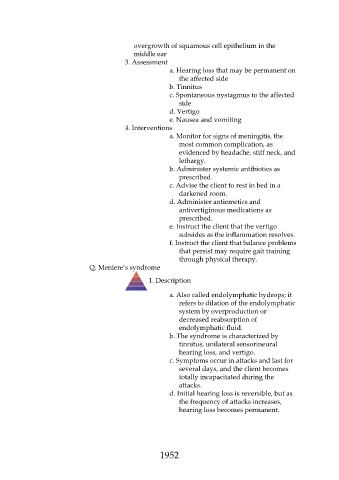Page 1952 - Saunders Comprehensive Review For NCLEX-RN
P. 1952
overgrowth of squamous cell epithelium in the
middle ear
3. Assessment
a. Hearing loss that may be permanent on
the affected side
b. Tinnitus
c. Spontaneous nystagmus to the affected
side
d. Vertigo
e. Nausea and vomiting
4. Interventions
a. Monitor for signs of meningitis, the
most common complication, as
evidenced by headache, stiff neck, and
lethargy.
b. Administer systemic antibiotics as
prescribed.
c. Advise the client to rest in bed in a
darkened room.
d. Administer antiemetics and
antivertiginous medications as
prescribed.
e. Instruct the client that the vertigo
subsides as the inflammation resolves.
f. Instruct the client that balance problems
that persist may require gait training
through physical therapy.
Q. Meniere’s syndrome
1. Description
a. Also called endolymphatic hydrops; it
refers to dilation of the endolymphatic
system by overproduction or
decreased reabsorption of
endolymphatic fluid.
b. The syndrome is characterized by
tinnitus, unilateral sensorineural
hearing loss, and vertigo.
c. Symptoms occur in attacks and last for
several days, and the client becomes
totally incapacitated during the
attacks.
d. Initial hearing loss is reversible, but as
the frequency of attacks increases,
hearing loss becomes permanent.
1952

